
Time for Some New Thinking: Changing how Organizations Create Transactional Documents
Ron MacInnis is a long-time document automation entrepreneur. He is the founder and CEO of Document Agility. Ron had previously founded and led AccuDraft, a document generation company serving financial services organizations, which was acquired by Thomson Reuters.
Document Agility is a SaaS application designed to facilitate collaborative document generation for organizations of all sizes. Document Agility is built on HotDocs Cloud Services, a hosted document generation platform.
The Struggle to Create Transactional Documents Efficiently
Nearly all business transactions a company originates require documents to memorialize what was agreed to and amendments if anything changes. Although some of these documents are forms, checklists, and simple communications, most of them are paragraph-style agreements that are complex, highly customized, and often regulated.
Organizations we talk with tell us that they face three major challenges when creating these types of transactional documents:
- Inefficient, lengthy, and expensive creation processes
- Uncertain document accuracy
- Limited access to the data within documents
Today’s Distributed, Mobile Workforce is the Central Challenge
In today’s world of distributed and mobile workers, most business processes require collaboration among teams. This is especially true of generating transactional documents. Consider the two basic stages of the process: gathering transaction data from the people and systems that have it, and translating that data into the required documents. The data gathering process is highly collaborative, but the language in transactional documents is far too complex and regulated to be created by users that contribute text. Instead, generating transactional documents requires that users collaborate on collecting data, which is then translated into required documents.
This process of coordinating the data contributions of multiple teams has proven to be incredibly challenging for most organizations – especially considering the number of contributors involved – from internal groups to clients as well. Transactional documents are truly “crowd-sourced,” and the contributors are often in multiple locations using various devices to perform their work.
In this distributed work environment, data is most often contributed to the document process in unstructured ways—by email, spreadsheets, and even paper checklists. These methods are highly inefficient. They are not integrated with systems that create documentation, so information must be copied manually into others systems. Given that studies show a 1% keystroke error rate and a 1.7% spreadsheet cell error rate, re-copied information is at risk for error. Additionally, with so much noise in the inbox, information conveyed through email is always at risk of being lost or simply never acted upon.
The breakdown in efficiency caused by disjointed, manual data contribution processes costs organizations big money. Analyst Aberdeen Group estimates that poor contract processes in the contract-to-purchase cycle cost Global 2000 organizations on average 5% of revenue.
A New Approach
Document Agility helps organizations overcome these challenges by changing how they approach document generation. Consider two common document technologies that were disruptive forces when they first appeared. In the early 1990s, Document Assembly technology was introduced and has greatly improved the creation of legal documents. In 2006, with the introduction of Google Docs™, users have been able to collaborate on the creation of static documents. While neither of these technologies alone addresses the critical challenges inherent in generating transactional documents, Document Agility has blended elements of both into a unified approach we call Collaborative Document Generation.
Collaborative Document Generation first requires that organizations think differently about the process of gathering data from their distributed and mobile contributors. To do this we developed an approach we call Distributed Data Assembly—a technology for enabling teams to collaborate on contributing data to the document generation process. Each data contributor – a team of people or business system –sequentially adds its unique information to an accumulating set of data that can be efficiently moved between teams throughout an organization. Along the way data is being “assembled” into an accurate, cumulative representation of a given transaction.
Collaborative Document Generation also requires that organizations think differently about how they create documents from the data collected. In most organizations, after transaction data has been collected, the required documents are created when legal staff interpret the data and create documents by manually word processing them or selecting clauses in a Contract Management system.But the interpretation process, by its very nature, opens the possibility for error, and it places the most time-intensive and difficult part of the document creation process squarely at the doorstep of the legal department—the group with the highest cost, and fewest members.
Document Agility teaches organizations a new approach to transactional document generation we call Rules-Based Document Creation. This process uses business rules to generate documents directly from transactional data itself by integrating Distributed Data Assembly with Document Assembly, using the industry-leading HotDocs™ platform. This approach eliminates the legal department bottleneck, guarantees that documents are uniform and compliant, and allows legal resources to concentrate on higher-margin activities.
Document Agility Enables Collaborative Document Generation in the Cloud
Document Agility allows organizations to implement Collaborative Document Generation right away. It’s a cloud-based, ready-to-use application that can be highly customized, yet requires no IT projects to implement. Organizations can capture data from their distributed, mobile workforces, quickly turn that data into accurate, customized documents, and use the data they collect to run their businesses.